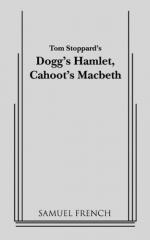|
This section contains 303 words (approx. 1 page at 400 words per page) |

|
Dogg's Hamlet, Cahoot's Macbeth Summary & Study Guide Description
Dogg's Hamlet, Cahoot's Macbeth Summary & Study Guide includes comprehensive information and analysis to help you understand the book. This study guide contains the following sections:
This detailed literature summary also contains Bibliography on Dogg's Hamlet, Cahoot's Macbeth by Tom Stoppard.
Dogg's Hamlet and Cahoot's Macbeth are two one-act plays by Tom Stoppard, which are often performed together as Dogg's Hamlet, Cahoot's Macbeth. First published together in England in 1979, the two plays were inspired by separate sources. Dogg's Hamlet is an expanded version of two earlier, similar plays. The play is based on a section of the philosophical investigations by Ludwig Wittgenstein, who explored how people use language to communicate. The play introduces an alternate language, called Dogg, which uses English words that have different meanings in Dogg. This inconsistency leads to confusion on the part of the play's characters, who try to communicate in their respective languages, English and Dogg. By the end of this first play, the English-speaking character, Easy, is speaking Dogg.
Cahoot's Macbeth, which is more political in nature, was dedicated to a Czechoslovakian playwright, Pavel Kohout. Because censorship in his country prevented public theatrical productions, Kohout wrote an abbreviated version of Shakespeare's Macbeth, which he performed in people's living rooms. Stoppard's play features a similar living-room theatre production of Macbeth, which gets broken up by an inspector, who threatens to arrest the actors and audience members for breaking the censorship rules. However, Easy, the English-speaking character from the first play, arrives and teaches the actors Dogg. When the inspector comes back a second time and catches them speaking entirely in Dogg, he cannot arrest them because he does not understand what they are saying. Both plays are united in their use of a common invented language, but they also explore how manipulations of language—a characteristic technique of Stoppard's drama—can be used in various political and nonpolitical ways. A current copy of Dogg's Hamlet, Cahoot's Macbeth can be found in The Real Inspector Hound and Other Plays, which was published by Grove Press in 1998.
Read more from the Study Guide
|
This section contains 303 words (approx. 1 page at 400 words per page) |

|



